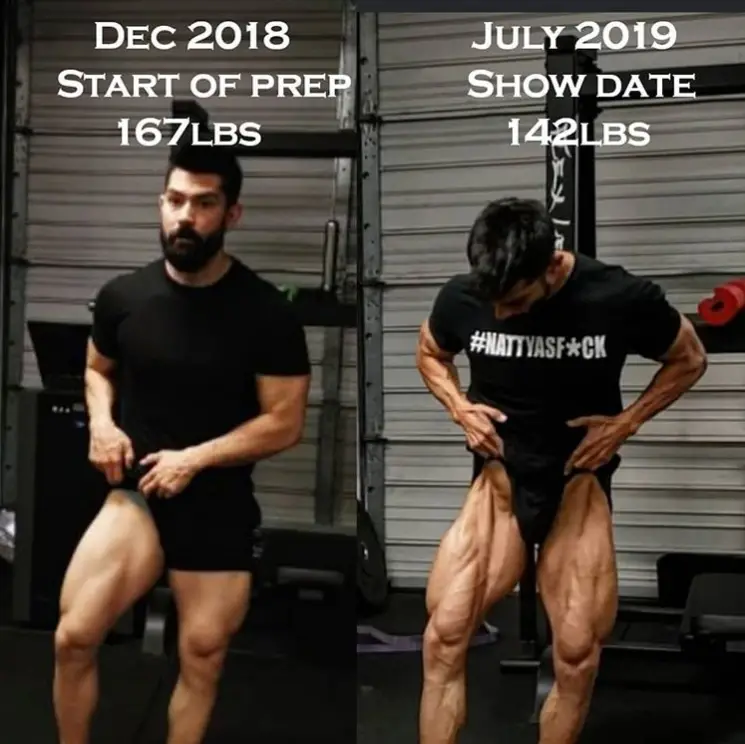There are many fads, secrets, diets, supplements, nutritional protocols, and tricks when it comes to fat loss.
Of course, most of them are completely inaccurate or, worse, counterproductive, and harmful.
There are very few fundamentals that work and deliver the desired results.
And while the basics of fat loss have been known for a while now (a calorie deficit, an adequate protein intake, resistance training, and plenty of sleep), one new technique has been gaining a lot of attention lately.
The technique in question is the use of weighted apparel during fat loss.
But is it a gimmick? Yet another marketing ploy, designed to help gurus sell weighted vests? Or is it the real deal? Plus, what does the tactic entail?
Let’s find out.
The Curious Case Study of Eric Lee Salazar
Eric Lee Salazar underwent a contest prep that lasted from November to April (for 19 or 20 weeks). His starting weight was 165 pounds, and the objective was to lose about 0.5% of his body weight per week, so roughly 0.8 pounds at the start. This is right in line with the recommended loss of 0.5 to 1 percent per week for maximum lean mass retention (1). His starting calories were 2,300 per day, or about 300 below maintenance, which is a pretty reasonable deficit.
The premise of this experiment was quite simple:
To replace the lost body weight with weighted apparel and see what effects that would have on this caloric intake over the weeks and his fat loss results.
Over the entire prep, Eric lost 19 pounds which was a bit over the anticipated 0.5 percent per week, but not by too much. That rate of weight loss averaged out to about 0.7 percent per week.
Big whoop, right? What’s so special about it?
Well, in a typical fat loss plan, we need to make adjustments to our caloric intake, activity level, or both as the weeks go by so we can continue to get leaner. For example, if you start on 2,300 calories per day, as Eric did, you would eventually have to lower them as you get leaner:
- Weeks 1-4: 2,300 calories
- Weeks 5-6: 2,200 calories
- Weeks 7-8: 2,100 calories
- Etc.
Or increase your activity:
- Weeks 1-4: 40 minutes of steady-state cardio
- Weeks 5-6: 60 minutes of steady-state cardio
- Weeks 7-8: 80 minutes of steady-state cardio
- Etc.
Or:
- Weeks 1-4: 8,000 steps per day
- Weeks 5-6: 9,500 steps per day
- Weeks 7-8: 11,000 steps per day
That’s pretty basic. But, here’s the thing:
Eric kept his caloric intake, and daily step count consistent throughout the entirety of his contest preparation. Yes, he kept his calories at 2,300 and step count at 9,500 for the first sixteen weeks.
But how was he able to do that without plateauing?

Well, rather than adjust his caloric intake and activity level, he changed the amount of weight he was carrying around all day. And while body weight isn’t the only factor that affects our metabolic rate, it’s among the primary ones (2).
One could argue that, while this still is an adjustment to be made and monitored, it’s more comfortable and less invasive to live with. Eric didn’t add any extra weight to himself for the first four weeks. In that time, he went down from 165 to 158.5 pounds, which was about 6.5 pounds of weight loss. At the start of week 5, Eric added a 12-pound vest on himself which bumped him to about 170 pounds.
He wore that vest daily and had it on him almost everywhere. He kept wearing it up until the end of week 8.
At the end of week 8, Eric switched to a 20-pound vest, which bumped him to over 170 pounds. At week 12, Eric was down to 150 pounds of body, weight which put him at 170 pounds in total.
It looks like Eric wore the Aduro Sport Weighted Vest. <- Click this link if you would like to view it on Amazon. Right now it has a 4.5 star rating with over 1,700 reviews. It comes in 5 options ranging from 4 to 25 lbs.
For weeks 12 to 16, Eric also added a couple of two-pound ankle weights in addition to his 20-pound vest, which put him at a total weight of 174 pounds (146 of which were his true body weight), or about 9 pounds over his starting contest preparation weight.

After week 16, Eric added even more weight on himself and went just over 180 pounds of total weight. And, to remind you, his calories and daily steps were kept consistent throughout all of this. The only exception here is that Eric dropped his calories to about 1,650 per day for three weeks, which was still over his typical intake of 1,400-1,500 during previous contest preps.
Eric ended up getting shredded, won the show, and got his IFBB Pro Card. What’s even more interesting is that he didn’t experience the typical symptoms of contest preparation, such as brain fog (3). Eric also reportedly maintained his leg size and strength much better during that period because he had to carry a heavier body everywhere.
Eric said that this was the easiest prep he had ever done – he didn’t experience the typical symptoms and didn’t have issues with binges or food obsession.
So, it’s clear that fat loss alone isn’t what brings about adverse side effects such as lethargy, brain fog, food obsession, and metabolic adaptation (2, 3). Body weight also matters a lot, and it appears to influence the metabolic rate heavily.
Another solid reason why Eric’s prep was so effective likely has to do with the fact that it was much more relaxed and less noticeable for him to carry some extra weight on himself than to, say, add an extra hour of cardio for the week or drop his calories even further.
Okay, with the experiment out of the way, let’s take a look at the science behind it all.
Is This Experiment Grounded In Science: What Does The Research Say?
Four are the primary factors that primarily affect our fat loss results and our ability to then maintain the progress we’ve made:
- Non-exercise activity thermogenesis (NEAT).
- Total daily energy expenditure (TDEE).
- Energy flux state.
- Gravitostat.
Let’s take a look at each individually:
1) Non-exercise activity thermogenesis.
NEAT represents all of the activities we do in our daily lives – from walking to the mailbox to get your letters to moving around your chair at work. As you can imagine, NEAT makes up the majority of the calories we burn from physical activity.
Two significant factors broadly impact our NEAT: body weight and energy levels (the more tired you feel, the less you tend to move around).
As you become lighter, your NEAT goes down. It’s one thing to carry around a 200-pound body everywhere, and it’s a whole other deal to carry 175 pounds around.
At 200 pounds (roughly 91 kilos), the average person, walking at a speed of 2.5 mph (4 kph or 66.6 meters per minute) would burn… hmm, let’s see:
(66 * 0.1) + 3.5 = 10.1 ml/kg/min
We then calculate this as calorie expenditure by multiplying the above value by his weight in kg (91 kilos), dividing by 1,000 to convert to l/min, and then multiplying by five to get our calories burned per minute. So:
(10.1 * 91) = 919.1
(919.1 / 1.000) * 5 = 4.59 calories per minute
Now, if we do the same equation, but now our hypothetical person weighs 175 pounds (79 kg) instead of 200, his estimated caloric burn per minute of walking would be… 3.98 calories/min.
That might not seem like a big difference, but if we stretch that over an hour, he would burn 275 calories at 200 pounds. At 175 pounds, for the same amount of walking, he would burn 238 calories.

For every hour of walking, that same person would burn 37 fewer calories. As you can imagine, this will add up to a tremendous difference over a day, week, or even month. And that’s just the caloric burn from walking. We haven’t even touched on other daily activities.
And, to be clear, 2.5 miles (or 4 kilometers) equates to about 5.263 steps for the average person (4). If you average about 10.000 steps per day, you can easily multiply these values by two, which makes the difference even more noticeable.
So, using weighted apparel is a great way to replace the lost weight and maintain the original NEAT from when you first start dieting without having to add higher volumes of exercise to your week.
2) Total daily energy expenditure.
Unlike NEAT, which is primarily impacted by our body weight, our total energy expenditure is a bit more complicated. For the most part, our TDEE is dictated by the following:
- Basal metabolic rate (BMR) – the number of calories your body burns at rest.
- Physical activity – NEAT + calories burned during training.
- Thermic effect of food (TEF) – the number of calories your body expends to break down the food you consume.
We can’t control our BMR, and we can only slightly influence TEF by increasing our protein intake (5). But, as you saw from the above section on NEAT, we can most definitely impact the number of calories we expend through physical movement.
If we use a BMR calculator and the Harris-Benedict equation (using the 1.55 value), we can calculate Eric’s TDEE:
- At the start of his contest prep (at 165 pounds) – 2.644 calories/day.
- At 181 pounds (through the use of weighted apparel) – 2.799 calories/day.
- And at the end of his prep without the extra weight (146 pounds) – 2.461 calories/day.
Of course, I do realize that none of the above calculations take leptin into account (which is synthesized in our fat tissue and impacts metabolic rate), but I reckon the difference isn’t that big and wouldn’t make as much of a difference as body weight does.
Plus, we also have to take into account the interference effect of cardio on weight training (6). Eric was able to get away with no cardio, which undoubtedly allowed him to put more effort into his weight training and retain his muscle and strength much better.
View this post on Instagram
3) Energy flux state.
“Long-term maintenance of weight loss requires sustained energy balance at the reduced body weight. This could be attained by coupling low total daily energy intake (TDEI) with low total daily energy expenditure (TDEE; low energy flux), or by pairing high TDEI with high TDEE (high energy flux).”
-Melby et al. (7)
In other words, fat loss and fat loss maintenance can be achieved in a couple of ways:
1) Having low energy expenditure and consuming fewer calories.
2) Having a high energy expenditure and consuming more calories.
During a traditional fat loss phase (and, even more so during contest prep), we lose weight – that’s a given. This inevitably leads to a drop in our energy expenditure thanks to the decline in NEAT and metabolic adaptation (because the body becomes more efficient and uses fewer calories to sustain itself and function) (2).
So, if you start dieting on a 500-calorie deficit, it will slowly become smaller as you diet and get leaner until, eventually, the number of calories that once equated to some form of a deficit is now your new level of maintenance. This is the essence of a low energy flux state.
This is why, as we diet, we gradually need to increase the level of physical activity and/or decrease our caloric intake to keep ourselves in a significant enough deficit. This is also why most folks struggle to maintain their fat loss once they’re done dieting – they have to eat too few calories and/or do too much cardio to keep their results, which is quite tricky.
Now, Eric’s experiment was done in a way that allowed him to stay in a high-ish energy flux state without having to pile on hours upon hours of weekly cardio. In other words, he was still in a deficit, but his maintenance was significantly higher and he was able to eat more calories while getting leaner. Plus, he also didn’t have to do tons of cardio, which is, at best, tedious, and, at worst, counterproductive as it interferes with our weight training performance (6).
And I probably don’t have to convince you that dieting on 2,300 calories per day is infinitely more sustainable and more enjoyable than dieting on, say, 1,500 calories.

4) Gravitostat.
For a long time, researchers have speculated that leptin is the only regulator of fat mass. The hormone is synthesized in our fatty tissue, so the more fat you accumulate, the higher your leptin gets, which, in turn, speeds up your metabolic rate and downregulates your appetite (8). Past a certain point, it becomes incredibly challenging to keep gaining fat because you need to keep increasing your caloric intake, but you no longer have the appetite.
On the other end of the spectrum, the leaner you become, the lower your leptin levels get. This increases your hunger levels and downregulates your appetite, which makes it challenging to get leaner and weight gain becomes much easier (8).
The decline in leptin levels is most likely the primary factor that leads to increases in hunger during fat loss. Research even suggests that declining leptin levels have a greater impact on leaner folks (9).
Where the term ‘gravitostat’ comes in, however, is with the idea that leptin may not be the only regulator of fat mass.
Recent research suggests that body weight may regulate fat mass independently of leptin (9). In that particular study, a group of obese rats and mice were implanted with loads, which made them lose weight. In comparison, the control group didn’t lose any weight.
At the end of the study, both groups of rodents were at a similar weight – the control group stayed obese, but the experimental group had lost weight equivalent to the loads they were implanted with.
What’s interesting is that the ‘loaded’ rodent group didn’t lose weight thanks to an increase in energy expenditure – they began eating less food. What’s even more exciting is the fact that these rodents lost their hunger despite their leptin levels going down due to the reduction in fat mass.
Once the weight implants were removed from the rodents in the experimental group, all of them regained the weight they had managed to lose and keep off previously.

This study suggests that there may be another mechanism that regulates body weight and fat mass, and that we could use it to our advantage for more natural fat loss and contest preparation.
Under normal circumstances, a drop in leptin would increase appetite. But, these rodents experienced the opposite, even though researchers allowed them to eat ‘ad libitum’ (as much as they wanted), which is quite impressive.
Granted, we need human trials before drawing any conclusions, but it certainly makes one wonder:
Is leptin the be-all, end-all for fat loss and fat loss maintenance, or is it possible that we’ve been arriving at one-sided conclusions so far?
Practical Applications, Recommendations, and Personal Thoughts On This Experiment
As someone who hates dieting with a passion (but still sees it as a necessary evil every once in a while), I’m quite excited about the idea of weighted apparel, and I’m eagerly waiting to see what human research might reveal in the next decade or two.
At this point, Eric’s case study appears promising, and it could very well be a fantastic way for us to lose fat and keep it off much more effortlessly. If you’re interested in experimenting with it yourself, here’s how to go about it:
1) Begin your fat loss phase as you usually would. Start with a consistent level of physical activity and a small to moderate deficit. Don’t use weighted apparel in the first few weeks of dieting.
2) Once you’ve lost at least five to six pounds, add weighted apparel to bring your body weight back to the original value or maybe a couple of pounds over. But don’t go any heavier than that. Your body needs time to adjust, so adding too much weight too quickly won’t be good for your long-term progress.
3) For weighted apparel to be useful, you need to wear it for the majority of your waking hours, and you should spend at least some of the time standing and walking around. For reference, Eric wore his weighted apparel for 90-95 percent of each day and averaged about 9,500 steps.

4) Don’t lower your calories or increase your physical activity (e.g., by adding cardio). Making sure to keep your body weight at (or slightly above) your starting value should be enough to keep you losing fat at a steady pace. If your goal is stage-ready conditioning, you may need to drop your calories for the last two to three weeks leading up to the contest. But, other than that – and for general fat loss – keeping your weight around the starting value and your activity level consistent should be more than enough.
Before wrapping this guide up, I’d like to address three concerns I have with wearing weighted apparel:
1) Weighted apparel might not be as useful for people who spend the majority of their days seated. Keep in mind that Eric spent a good chunk of each day standing and moving around, so his NEAT naturally stayed high.
2) Weighted apparel can be challenging to wear everywhere, especially during the warmer months of the year. Weighted vests, in particular, can be bulky and difficult to wear. Sleek vests are an option, but a decent one will cost over $200.
3) While weighted apparel seems to work great for fat loss, I’m not too sure how effective it would be for fat loss maintenance, as that would mean that you would have to keep wearing such apparel for as long as you want to stay leaner. Like in the rodent study, as soon as you stop wearing it, your body weight will likely start creeping back up (9).

Conclusion
Wearing weighted apparel while dieting can most definitely work, and Eric’s case study is proof of that. The good news is, lifters interested in getting leaner for the summer and bodybuilders looking to get stage-ready can use this tactic to their advantage.
The bad news is, wearing weighted apparel might not be as good for the general population because that doesn’t seem like a sustainable tactic to maintain your fat loss results. It may sound simple enough, but it takes effort, a monetary investment, and careful planning.
If you want to try wearing a weighted vest for yourself, I suggest the Aduro Sport Weighted Vest. <- Click this link if you would like to view it on Amazon. Right now it has a 4.5 star rating with over 1,700 reviews. It comes in 5 options ranging from 4 to 25 lbs. Based on Erics pictures, I’m pretty sure this is the vest he wore.
I learned a lot about Eric while writing this article. It seems like he is an awesome guy. You can find him on Instagram @ifbbpro_ericleesalazar
Thank you for reading. If you liked this article, please share it and leave a comment below. Then, go Pump Some Iron!
Follow me / Pump Some Iron on Instagram for updates @pump.some.iron

